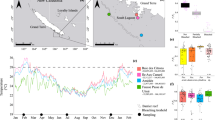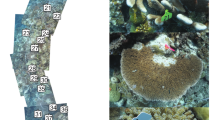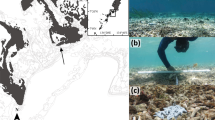Abstract
In order to reconcile existing data and hypotheses on the relationship outcomes of Caribbean Zoanthidea-Demospongiae symbioses, the context-dependent survival and growth (metrics of host sponge condition) were monitored for 8–12 months, with and without Zoanthidean symbionts, in native (coral reef) and novel (mangrove) habitats. Experiments repeated over space and time revealed significant positive effects of Zoanthidea colonization on metrics of host condition and indicated that the outcome of these symbioses can shift from mutualism to parasitism when transplanted to novel habitats. Although the precise mechanisms of the symbioses remain obscured and most of the species associations have not been examined, these experiments demonstrate an example where relationship outcomes are more conserved across their evolutionary history than host associations.




Similar content being viewed by others
References
Arillo A, Bavestrello G, Burlando B, Sarà M (1993) Metabolic integration between symbiotic cyanobacteria and sponges: a possible mechanism. Mar Biol 117:159–162
Beaulieu SE (2001) Life on glass houses: sponge stalk communities in the deep sea. Mar Biol 138:803–817
Bergstrom CT, Lachmann M (2003) The red king effect: when the slowest runner wins the coevolutionary race. Proc Natl Acad Sci USA 100:593–598
Brümmer F, Pfannkuchen M, Baltz A, Hauser T, Thiel V (2008) Light inside sponges. J Exp Mar Biol Ecol 367:61–64
Crocker LA (1977) The ecology of the zoanthid-sponge symbiosis in Barbados. McGill University, Thesis
Crocker LA, Reiswig HM (1981) Host specificity in sponge-encrusting Zoanthidea (Anthozoa, Zoantharia) of Barbados, West-Indies. Mar Biol 65:231–236
Erwin PM, Thacker RW (2008) Cryptic diversity of the symbiotic cyanobacterium Synechococcus spongiarum among sponge hosts. Mol Ecol 17:2937–2947
Gaino E, Sarà M (1994) Siliceous spicules of Tethya seychellensis (Porifera) support the growth of a green alga: a possible light conducting system. Mar Ecol Prog Ser 108:147–151
LaJeunesse TC, Thornhill DJ, Cox E, Stanton F, Fitt WK, Schmidt GW (2004) High diversity and host specificity observed among symbiotic dinoflagellates in reef coral communities from Hawaii. Coral Reefs 23:596–603
Lewis SM (1982) Sponge–zoanthid associations: functional interactions. Smithson Contrib Mar Sci 12:465–474
Pawlik JR, Chanas B, Toonen RJ, Fenical W (1995) Defenses of Caribbean sponges against predatory reef fish. I. Chemical deterrency. Mar Ecol Prog Ser 127:183–194
Peterson AT, Soberón J, Sánchez-Cordero V (1999) Conservatism of ecological niches in evolutionary time. Science 285:1265–1267
Randall JE, Hartman WD (1968) Sponge-feeding fishes of the West Indies. Mar Biol 1:216–225
Saffo MB (1992) Coming to terms with a field: words and concepts in symbiosis. Symbiosis 14:17–31
Sinniger F, Montoya-Burgos JI, Chevaldonné P, Pawlowski J (2005) Phylogeny of the order Zoantharia (Anthozoa, Hexacorallia) based on the mitochondrial ribosome genes. Mar Biol 147:1121–1128
Sipkema D, Blanch HW (2010) Spatial distribution of bacteria associated with the marine sponge Tethya californiana. Mar Biol 157:627–638
Smith DC (1992) The symbiotic condition. Symbiosis 14:3–15
Steindler L, Huchon D, Avni A, Ilan M (2005) 16S rRNA phylogeny of sponge-associated cyanobacteria. Appl Environ Microbiol 71:4127–4131
Swain TD (2009) Phylogeny-based species delimitations and the evolution of host associations in symbiotic zoanthids (Anthozoa, Zoanthidea) of the wider Caribbean region. Zool J Linn Soc 156:223–238
Swain TD (2010) Evolutionary transitions in symbioses: dramatic reductions in bathymetric and geographic ranges of Zoanthidea coincide with loss of symbioses with invertebrates. Mol Ecol 19:2587–2598
Swain TD, Wulff JL (2007) Diversity and specificity of Caribbean sponge-zoanthid symbioses: a foundation for understanding the adaptive significance of symbioses and generating hypotheses about higher-order systematics. Biol J Linn Soc 92:695–711
van Valen L (1973) A new evolutionary law. Evol Theory 1:1–30
van Valen L (1974) Molecular evolution as predicted by natural selection. J Mol Evol 3:89–101
West DA (1976) Aposematic coloration and mutualism in sponge-dwelling tropical zoanthids. In: Mackie GO (ed) Coelenterate ecology and behavior. Plenum Press, New York, pp 443–452
Willenz Ph, Hartman WD (1994) Skeletal reaction of the Caribbean coralline sponge Calcifibrospongia actinostromarioides Hartman toward an epizoic Zoanthidean. In: van Soest RWM, van Kempen TMG, Braekman JC (eds) Sponges in time and space: biology, chemistry. Paleontology, Balkema, pp 279–288
Wulff JL (1986) Variation in clone structure of fragmenting coral reef sponges. Biol J Linn Soc 27:311–330
Wulff JL (1994) Sponge-feeding by Caribbean angelfishes, trunkfishes, and filefishes. In: van Soest RWM, van Kempen TMG, Braekman JC (eds) Sponges in time and space: biology, chemistry. Paleontology, Balkema, pp 265–271
Wulff JL (1995) Sponge-feeding by the Caribbean starfish Oreaster reticulatus. Mar Biol 123:313–325
Wulff JL (2000) Sponge predators may determine differences in sponge fauna between two sets of mangrove cays, Belieze Barrier Reef. Atoll Res Bull 477:251–263
Wulff JL (2001) Assessing and monitoring coral reef sponges: why and how? Bull Mar Sci 69:831–846
Wulff JL (2005) Trade-offs in resistance to competitors and predators, and their effects on the diversity of tropical marine sponges. J Animal Ecol 74:313–321
Wulff JL (2008) Life history differences among coral reef sponges promote mutualism or exploitation of mutualism by influencing partner fidelity feedback. Am Nat 171:597–609
Acknowledgments
The research presented here required hundreds of hours in the field and underwater working in difficult conditions; it could not have been accomplished without the tireless efforts of E. Bartels, A. Castillo, O. Drescher, and especially B. Biggs, D. Sobers, and T. Voeltz. I am grateful to the directors and staff of the Smithsonian Tropical Research Institute, Bellairs Research Institute, Mote Tropical Research Laboratory, Curaçao Sea Aquarium, Reefcare Curaçao, and Seru Boca Marina at Santa Barbara Plantation and the generous assistance of E. Bartels, R. Haynes, C. de Jong, D. Kolenousky, H. Lessios, S. Piontek, and A. Schrier. Dive support was provided by RV Lady Lynne, RV Less Stress, Hightide Watersports, Curaçao Sea Aquarium, and Silent Immersion. Special thanks to F. Delrosun for helping me to navigate the regulations of the Government of Curaçao. Thoughtful comments of B. Biggs, D. Levitan, T. Miller, and J. Wulff improved earlier versions of the manuscript. This research is supported by the Smithsonian Tropical Research Institute short-term fellowship, AMNH Lerner-Gray Fund for Marine Research, Margaret Y. Menzel Award for Outstanding Research, Jack Winn Gramling Award in Marine Biology, and National Science Foundation under grant number OCE-0550599 (J. Wulff). This research is dedicated to the memory of Maryke Kolenousky, whose immense love of the sea was best expressed in her photography and conservation efforts through Reefcare Curaçao.
Author information
Authors and Affiliations
Corresponding author
Additional information
Communicated by M. Kühl.
Rights and permissions
About this article
Cite this article
Swain, T.D. Context-dependent effects of symbiosis: Zoanthidea colonization generally improves Demospongiae condition in native habitats. Mar Biol 159, 1429–1438 (2012). https://doi.org/10.1007/s00227-012-1919-4
Received:
Accepted:
Published:
Issue Date:
DOI: https://doi.org/10.1007/s00227-012-1919-4




